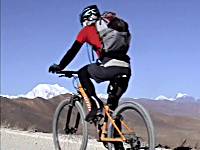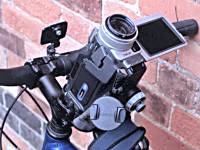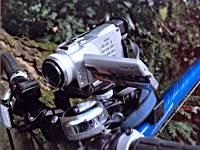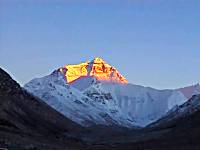
|
The world of non-commercial film and A-V |
Events Diary | Search | ||
| The Film and Video Institute | | ||||
The making of High Road From Lhasa
To BIAFF 2008 results | To Making Of IndexHigh Road from Lhasa won 4-stars at BIAFF 2008
The Background to High Road From Lhasa
By David Newman FACI
 Several of my previous
films have been documentaries about walking and climbing in the great mountain
ranges of the world, often at high altitudes. I'm also a regular cyclist,
and was attracted to a group holiday run by the UK firm KE Adventure
Travel1. They offer a trip in which
you cycle 600 miles from Lhasa in Tibet to Kathmandu in Nepal, making a detour
to the foot of Everest. On the way it is necessary to cross five major passes
of around 17,000 feet. I was intrigued by how challenging it might be to
pedal to these altitudes, and thought this would make a good subject for
a movie, especially when set against the backdrop of a rapidly changing Tibet.
So in September 2006 I set off.
Several of my previous
films have been documentaries about walking and climbing in the great mountain
ranges of the world, often at high altitudes. I'm also a regular cyclist,
and was attracted to a group holiday run by the UK firm KE Adventure
Travel1. They offer a trip in which
you cycle 600 miles from Lhasa in Tibet to Kathmandu in Nepal, making a detour
to the foot of Everest. On the way it is necessary to cross five major passes
of around 17,000 feet. I was intrigued by how challenging it might be to
pedal to these altitudes, and thought this would make a good subject for
a movie, especially when set against the backdrop of a rapidly changing Tibet.
So in September 2006 I set off.
The trip didn't get off to a very good start. Having carried my bicycle, camera gear and luggage across London on the tube to Heathrow, it all weighed in at 43 Kilos and I was promptly charged £358 in excess baggage by Gulf Air. This is probably more than the bike was worth, and to think I had gone on a diet before the trip to get into better shape!
Lhasa airport is about 13,000 feet above sea level, and you start to feel the effects of the altitude even before stepping off the plane. Several members of the group suffered mild symptoms of high altitude sickness2 that night - headaches and nausea - and the problems continued as we set off on our ride.
I always tell people to keep the camera rolling when things get difficult. "When the going gets tough, the tough keep filming!" I have only ever partially achieved this, especially in High Road From Lhasa. Altitude is a great demotivator. Yes, I did pieces to camera in the Lhasa hotel joking about how altitude sickness is "Like a hangover without the pleasure beforehand." Yes, I filmed my cycling companions collapsed in the back of a minibus feeling rough. On the other hand I didn't film our well-practised mountain leader Mick Bromley asserting his authority over the Sherpa support team one evening. They had pitched camp too high for the well being of the clients at that stage in the trip. Despite their painstaking efforts he made them strip the camp even though it was nearly dark, and transfer operations to a spot 15 miles down the road.

 As
well as filming the other cyclists along the route I wanted to include shots
taken from a moving bicycle. These would give a better impression of what
it was like to be negotiating the traffic in the cities, or the exhilaration
of a rapid descent down one of the passes. The most stable way of doing this
that I found was to mount the camera on the bicycle cross-bar using a universal
bracket made by Hague3 in Nottingham.
To vary the shots the bracket could be mounted on other parts of the bike,
such as the front forks. I also did several pieces to camera whilst cycling
along with the camera pointing upwards at my face. These could be used as
an alternative to voiceover to narrate the film. Vibration proved to be an
issue on some of the poorer roads. Whilst the pictures were OK, and gave
a good impression of the terrain, the sound recording system didn't work.
Therefore wild tracks recorded in less bumpy conditions had to be used.
Amazingly, despite the punishment I gave the camera, it still appears to
work satisfactorily to this day.
As
well as filming the other cyclists along the route I wanted to include shots
taken from a moving bicycle. These would give a better impression of what
it was like to be negotiating the traffic in the cities, or the exhilaration
of a rapid descent down one of the passes. The most stable way of doing this
that I found was to mount the camera on the bicycle cross-bar using a universal
bracket made by Hague3 in Nottingham.
To vary the shots the bracket could be mounted on other parts of the bike,
such as the front forks. I also did several pieces to camera whilst cycling
along with the camera pointing upwards at my face. These could be used as
an alternative to voiceover to narrate the film. Vibration proved to be an
issue on some of the poorer roads. Whilst the pictures were OK, and gave
a good impression of the terrain, the sound recording system didn't work.
Therefore wild tracks recorded in less bumpy conditions had to be used.
Amazingly, despite the punishment I gave the camera, it still appears to
work satisfactorily to this day.
 There was plenty of
fine scenery to photograph along the way. To add fluidity to some of the
mountain shots I used time lapse photography. One evening we were lucky enough
to witness Mount Everest changing colour as the sun set. I left the camera
running for about an hour, paying one of our Sherpa cooks to stand guard
over it in case it was disturbed while we had dinner. The scene was compressed
into a few seconds of screen time. Unfortunately I didn't have much success
in modifying the colours at the editing stage to produce the rich, enhanced
sunset colours often seen on TV programmes. If anyone has experience of doing
this I'd be interested to hear from them.
There was plenty of
fine scenery to photograph along the way. To add fluidity to some of the
mountain shots I used time lapse photography. One evening we were lucky enough
to witness Mount Everest changing colour as the sun set. I left the camera
running for about an hour, paying one of our Sherpa cooks to stand guard
over it in case it was disturbed while we had dinner. The scene was compressed
into a few seconds of screen time. Unfortunately I didn't have much success
in modifying the colours at the editing stage to produce the rich, enhanced
sunset colours often seen on TV programmes. If anyone has experience of doing
this I'd be interested to hear from them.
Although the main subject of the film was the bike ride, there was plenty of opportunity to intersperse footage of cultural attractions. One monastery wanted over £100 to video inside - I didn't pay - while another one more off the beaten track welcomed the camera for a mere £1. I also tried to include evidence of the more recent developments in Tibet. For example, the brand new train that carries in tourists and migrants from Beijing, and fast food joints springing up in Lhasa.
My team mates on the holiday were keen to see the fruits of my labours. I wasn't prepared to send them poor quality unedited footage, nor could I commit to a timescale for the finished product. The deal we struck was that I would send them all a free copy of the competition entry at an unspecified date in the future, in return for them making a donation to a Nepalese charity supported by KE Adventure Travel.
Due to a very large number of IAC commitments the editing of this film dragged on. I realised that the 2008 IAC Competition was my last chance for the film to have maximum impact. Beyond that, due to the rapid pace of change in Tibet, it would probably have passed its sell-by date. Since shooting I gather the Chinese have laid tarmac all the way to Everest Base Camp in preparation for the passage of the Olympic Torch. Clearly I could not have anticipated the degree of unrest that has taken place recently in Tibet, but maybe the film gives some insight into the background behind it.
- David Newman, April 2008
| 1 | KE Adventure travel (www.keadventure.com) - the name comes from their start as "The Karakoram Experience" when they wanted to share their delight in exploring the Karakorum Mountain Range with others. They are keen supporters of Responsible Tourism. |
| 2 | Altitude sickness usually occurs above 2,400 metres(approximately 8,000 feet). It is due to reduced air-pressure allowing less oxygen to reach the body. Symptoms normally clear within a day or two. Its symptoms include headache, fatigue, stomach illness, dizziness, and sleep disturbance and … exertion aggravates the symptoms! |
| 3 | Hague Camera Supports (www.b-hague.co.uk) make a wide range of fascinating gear for photographers and video makers. Most of their products are available at www.cameragrip.co.uk |
Share your passions.

Share your stories.